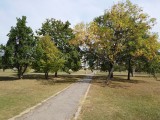Sony Xperia 5 II review

Top-quality triple camera
The Xperia 5 II has the same camera system as the bigger 1 II. Or almost the same - it's missing the ToF emitter/receiver combo, which could potentially be slightly detrimental to low-light nearby focusing or subject isolation in portrait mode - more on that below.
 Camera parity between the 1 II (left) and the 5 II
Camera parity between the 1 II (left) and the 5 II
Sony insists that the high-res Quad Bayer (or Nonacell) sensors are too slow to read out, and opts for a 12MP main camera that offers much better speed - 10ms vs. the 30ms they quote for a 12MP shot out of the 108MP Samsung solution and 100ms for a full-res 108MP picture. The sensor isn't small by any stretch either - it's a 1/1.7" imager with 1.8µm pixels and dual photo-diode autofocus. A fast f/1.7 aperture lens sits in front of it, with an equivalent focal length of 24mm, stabilized too.
There's an ultra wide-angle cam too, of course. This one has a 16mm focal length and can autofocus, plus it uses a big-for-an-ultra-wide 1/2.55" sensor. The telephoto completes the camera trifecta with a 70mm equivalent focal length and 3x optical zoom.
Once again, there are no improvements on the selfie front - the camera is the same 8MP unit with a 24mm equivalent lens with an f/2.0 aperture and fixed focus that you get on the Xperia 1 II, but also on Mark One 1 and 5.

Predictably, there is a total of three camera apps - the vanilla one you're likely to be using most of the time, as well as the Photography Pro and Cinematography Pro apps for more advanced shooting.
The 'simple' app is entirely identical as on the Xperia 1 II. There's a camera selector with tree designation for direct access to each module - no need to cycle between them to get to the one you need as is on the 5 Mark One.
Side swipes switch between stills and video while swiping down (but not up) toggles between the front and rear cams. The far end of the viewfinder has controls for flash, bokeh mode, aspect ratio, implicit white balance and exposure compensation adjustment, an extra toggle for switching between front and rear cams, and a cog wheel to take you to settings.
A Mode button in the vicinity of the shutter release gives access to extra modes like Panorama and Creative effect (a.k.a. filters), and the last mode you pick from here gets promoted to a sticky position for quick access from the viewfinder.
There is no Manual mode in the simple app, but there's a whole 'manual' app - Photo(graphy) Pro. It's got its interface strongly inspired by Sony Alpha mirrorless cameras and offers a lot of control, but it is also a bit clunky to operate. We went into more detail in the Xperia 1 II review, and since the app is the same, feel free to head there for the full scoop.
As for the video-only Cinema Pro app, we have a dedicated article going over its functionality on the Xperia 1 II.
A new addition on the Xperia 5 II is the ability to record 4K at 120fps in HDR - Sony says the Xperia 5 II is the first phone to do that.
Daylight image quality
In daylight, the Xperia 5 II captures photos that are practically indistinguishable from the ones taken by the Xperia 1 II. That is mostly a good thing.
We generally enjoy the more restrained processing in terms of sharpening that leaves fine details natural looking. Noise suppression isn't as strong as on Samsungs, though noise is still controlled excellently.








Daylight comparison: Xperia 5 II • Xperia 1 II
Another point where the 5 II, just like the 1 II, remains conservative is HDR. It doesn't strive to recover all of the highlights and boost all of the shadows and instead produces more contrasty, more 'photographic' and less 'instagram'-y shots.
Having said all that, if you're coming from a Samsung or maybe a Xiaomi, and you're one to prefer your images with more punch straight out of the camera, the Xperia's tendency for moderation may not be immediately appreciated.








Daylight samples, main cam, default Camera app
There's a way to get images with a more HDR look out of the Xperia. That's the Photo Pro app with the DRO/Auto HDR setting in the Auto HDR state. The differences are often minuscule, particularly so in evenly lit scenes. Still, for high-contrast shots like the one of the snail, you get much better tonal development on both ends of the histogram.








Daylight samples, main cam, Photo Pro app, Auto HDR
In a few scenes, we specifically explored the four different 'modes' for exposure/HDR processing. In our experience here, the full auto from the vanilla Camera app was generally a close match for the DRO mode. Auto HDR does get you that boost in the shadows and better highlight retention, but the default Camera app will do just fine in most scenes.












HDR comparison, main cam: Camera app • Photo Pro Auto HDR • Photo Pro DRO • Photo Pro HDR off
The images out of the ultra-wide cam have similar properties to the ones from the main module. If we were to nitpick, there's a bit more noise and some purple fringing along high-contrast edges. However, dynamic range is wide, colors are nice without oversaturation, and fine detail is among the best you can get out of an ultra-wide cam.








Daylight samples, ultra wide cam, default Camera app
Having autofocus, the ultra-wide camera of the Xperia 5 II is well suited to exaggerated perspective shots with close-up subjects - something you can't really do with modules that have their focus fixed at infinity (like Galaxies and iPhones). Okay, maybe these quickly get old when you're trying to come up with stuff to shoot around the office, but the point is that the Xperia's ultra-wide has the autofocusing capability.



Daylight samples, ultra wide cam, default Camera app
Software distortion correction is available for the ultra wide-angle images giving you the familiar tradeoff between wider coverage and straight lines around the edges. We're leaning heavily towards the corrected option for regular shooting, though the bulging edges could be a look you may want on occasion.




Distortion correction: On • Off
We had a generally more positive experience with the Xperia 5 II's telephoto than what we observed on the 1 II. The images here are consistently sharp - that couldn't be said of the 1 II's 3x shots. Whether that's been achieved with a hardware or software tweak, we can't be sure, but 5>1 for us once more.








Daylight samples, telephoto cam, default Camera app
Here's a quick comparison.




Daylight comparison: Xperia 5 II • Xperia 1 II
Low-light image quality
The Xperia 5 II's low-light images are, again similar to those out of the Xperia 1 II, though somehow not quite the same. In our experience, the 5 II comes with slightly better-contained highlights, but the 1 II's photos are sharper - not huge differences in either respect, but they do exist.




Low-light comparison: Xperia 5 II • Xperia 1 II
Other than that, the Xperia look is maintained - the higher contrast means darker shadows than what most competitors will capture in the same circumstances. Still, the shadows do take a boost in post-processing nicely. Colors are well preserved, and there's no drop in saturation, plus the Xperia doesn't seem to have issues with white balance in warmly lit night scenes, a fairly popular problem for others.






Low-light samples, main cam, default Camera app
The Auto HDR mode in Photo Pro will brighten up the shadows a little for you, compared to the main app if you don't want to deal with them yourself in post. The effect is marginal, and there's little done for the highlights although this is sort of Night mode (without being called that) - it takes about two seconds to capture an image. There is some extra softness also introduced here. Overall, the Camera app does better, even if the photos could use some additional tweaking post shot.






Low-light samples, main cam, Photo Pro app, Auto HDR
In the other modes you won't be getting better results. Here are comparison shots with DRO and HDR off.












Mode comparison, main cam: Camera app • Photo Pro Auto HDR • Photo Pro DRO • Photo Pro HDR off
Provided it has some light to work with, the Xperia 5 II's ultra wide-angle cam can take good pictures. We'd have preferred brighter exposures than it typically delivers, but sharpness and detail are excellent, and color saturation is on point.






Low-light samples, ultra wide cam, default Camera app
The Xperia 5 II's telephoto cam is always used when you hit the 1 tree selector - there is no light threshold below which it'll default to the main one, and we appreciate that. It takes very respectable photos in low light too, with good detail, well-contained noise and saturated, if a little extra warm and reddish colors.






Low-light samples, telephoto cam, default Camera app
Once you're done with the real world samples, head over to our Photo compare tool to see how the Xperia 5 II stacks up against the competition.



Sony Xperia 5 II against the Xperia 1 II and the Galaxy S20 in our Photo compare tool
Low-light focusing
Since Sony didn't fit a ToF camera on the Xperia 5 II and one of its supposed uses on the 1 II was for low-light focusing aid, we figured we'd compare how the two phones behave when having to focus in the dark. As the video below demonstrates, the Xperia 5 II is no slower than the 1 II. It's actually faster to find the eye on the face of the subject than the older phone. Oh well, the ToF camera won't be missed.
Portrait mode
Portrait mode on Xperias isn't in the mode selector, but is instead accessed from an icon in the viewfinder - not immediately obvious, but always in plain sight when you learn where it is. It delivers excellent subject separation, even without the ToF camera that the Xperia 5 II is missing, and the natural-looking background blur is just right at the default setting.
What's not so great is the apparent lack of HDR processing, leaving bright areas of the image completely blow out. We get that exposing for the face should be a priority, and that portrait shots are likely very processing-intense even without throwing HDR into the mix, but if others can do it, so too can Sony.
We were worried that with the scrapping of the ToF module, the Xperia 5 II wouldn't be able to do subject isolation quite as well as the 1 II. We did a bunch of side-by-side shots, and that turned out not to be the case. If anything, the small Xperia is better at it.








Portrait mode comparison: Xperia 5 II • Xperia 1 II
Selfies
The selfie camera on the Xperia 5 II is the same as on the previous Xperia 1, 5, and 1 II. It's not the best selfie cam possible, but it takes good pictures with nice colors and decent detail.
Selfie portraits haven't improved either, and if you get your entire face sharp in one shot, you consider yourself lucky. The missing HDR in this mode is less than ideal too.
Video recording
Using its default Camera app, the Xperia 5 II can record video up to 4K with each of its three cams, though it doesn't support 4K60. 1080p does offer the option for 30fps and 60fps frame rates. You get to choose between the h.264 and h.265 codecs for 4K video, while 1080p is encoded using the h.264 only. There's an HDR mode too, again on all three cams, and that one is in h.265 only.

If you use the Cinema Pro app, in addition to the advanced controls, you get to 4K at 60fps (played back at 60fps), as well as 4K at 120fps slow motion, which plays back at 24fps. The Cinema Pro's 4K is 3840x1644px (i.e. in 'cinematic' 21:9 ratio), however - it's worth keeping in mind when comparing against other smartphones with 'consumer' 4K (3840x2160px).
As expected based on our experience with the Xperia 1 II, the Xperia 5 II's main camera takes excellent 4K videos. With the relatively conservative processing, you're getting a natural look, everything is nice and detailed, and colors are spot-on.
The ultra wide-angle cam footage maintains the same properties. Colors and dynamic range are so closely matched that it's hard to tell it was shot on a different module and detail is hard to beat by a competing ultra-wide cam.
A very nice surprise is the 4K output from the Xperia 5 II's telephoto camera - it's leaps and bounds sharper than what we saw on the Xperia 1 II, and here it's as good on a pixel level as the main cam.
EIS is available in all modes on the Xperia 5 II. Sony makes a differentiation between Optical SteadyShot and plain SteadyShot in its camera specifications, but that's only to account for the lack of OIS on the 16mm cam - in essence, all three cams have EIS, the 24mm and 70mm ones also have OIS.
SteadyShot stabilizes footage recorded on the main and ultra-wide cameras fairly well though we had a more positive experience with the Xperia 1 II. This one has more visible global shake as well as some finer jittery motion. The telephoto camera's capture is about as shaky as what we saw on the 1 II - not really smooth, but not unusable either.
Here's a glimpse of how the Xperia 5 II compares to rivals in our Video compare tool. Head over there for the complete picture.



Sony Xperia 5 II against the Xperia 1 II and the Galaxy S20 in our Video compare tool
Reader comments
- Aelmi3h
- 22 Apr 2025
- fuf
Use Xperia firmware tool..
- Zul
- 25 Mar 2025
- K1L
Use this phone for 1 year,ar the 6 month of usage green line starts to appear this is the sad fact about this phone but i love this phone because of the performance and a lot of intresting features
- anotheronymous
- 16 Feb 2025
- Nxr
Upgrade to a custom ROM, preferably degoogled.




















